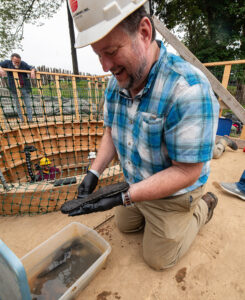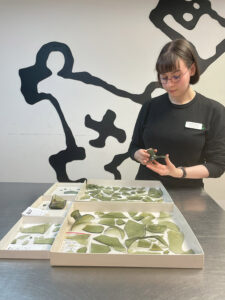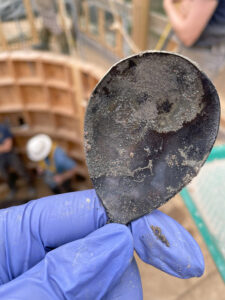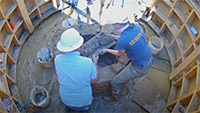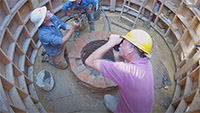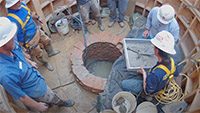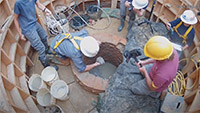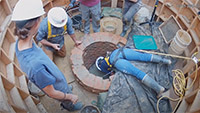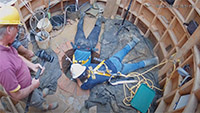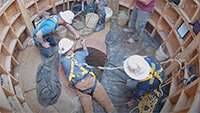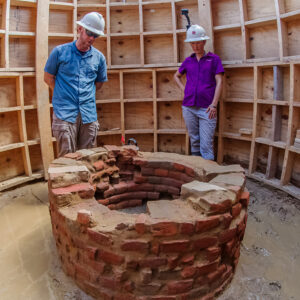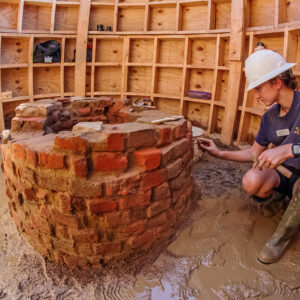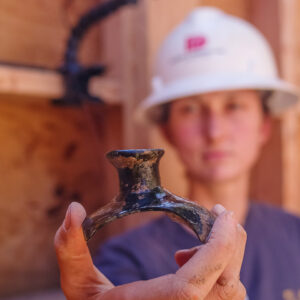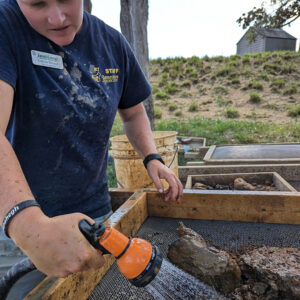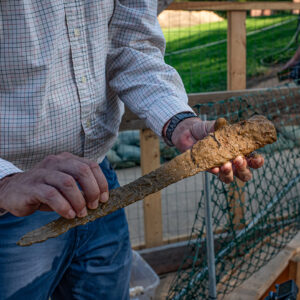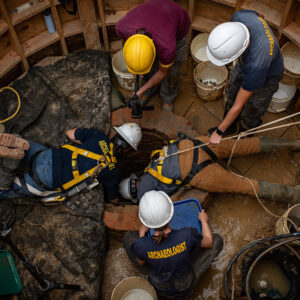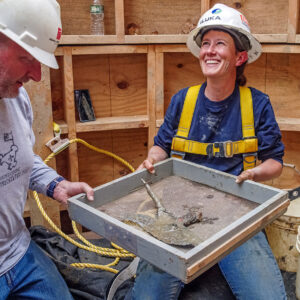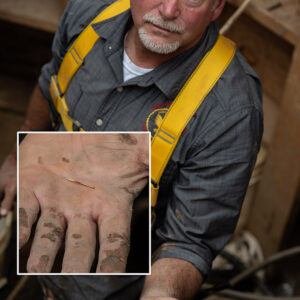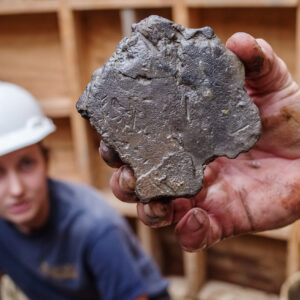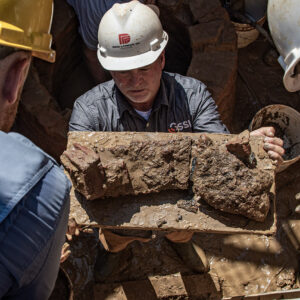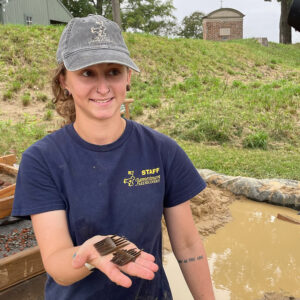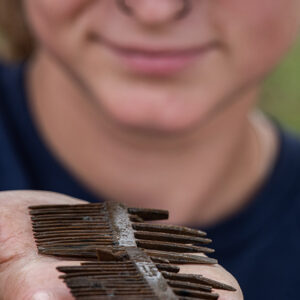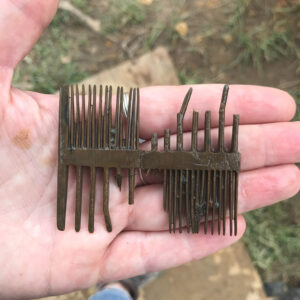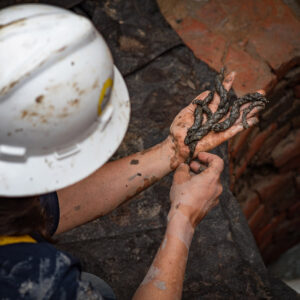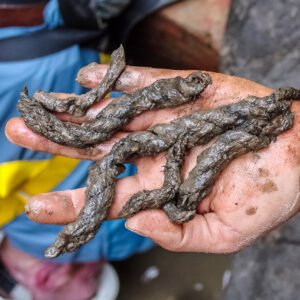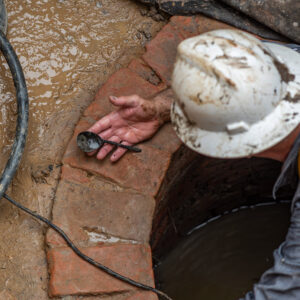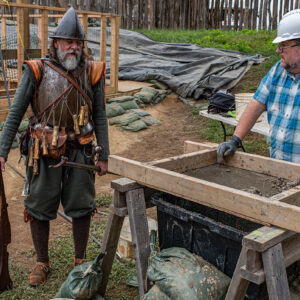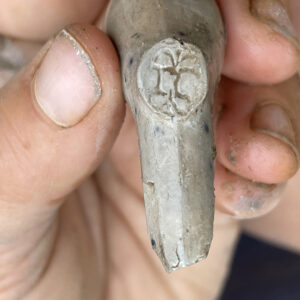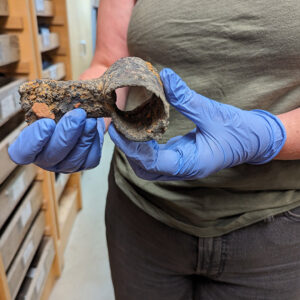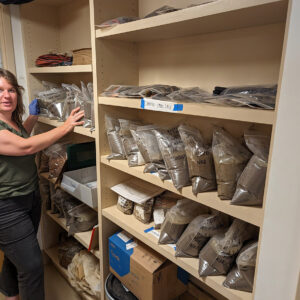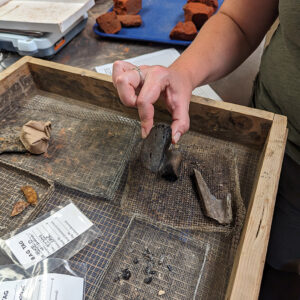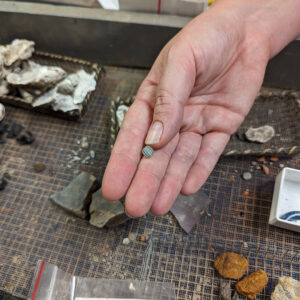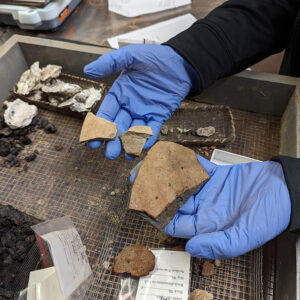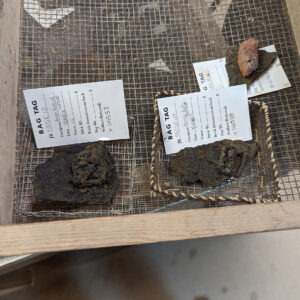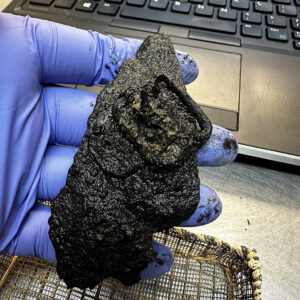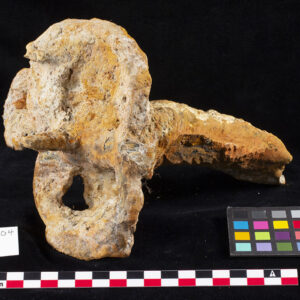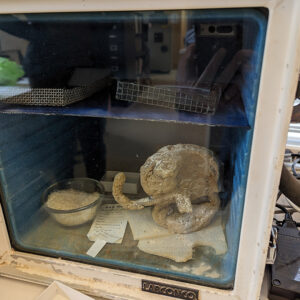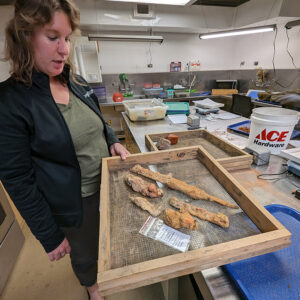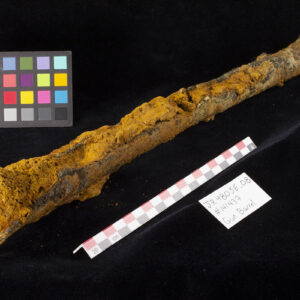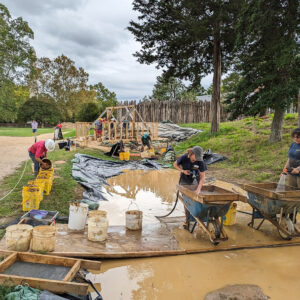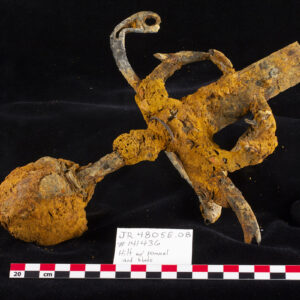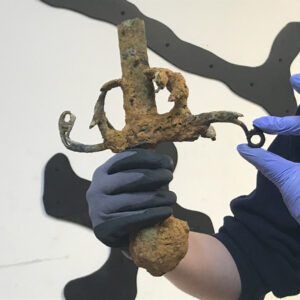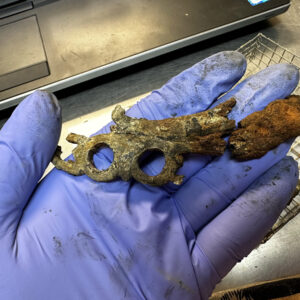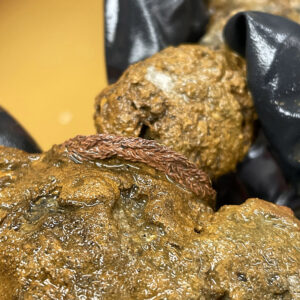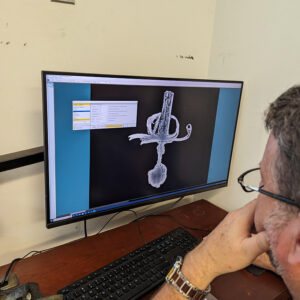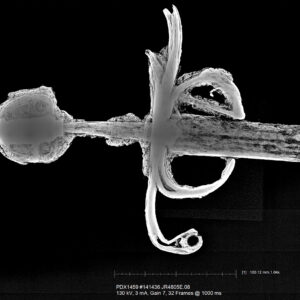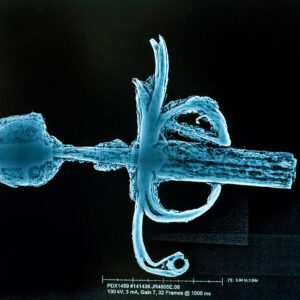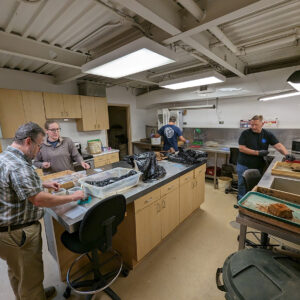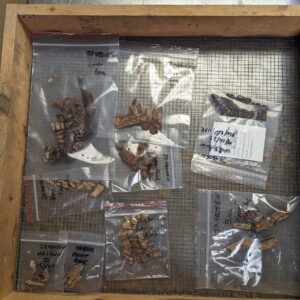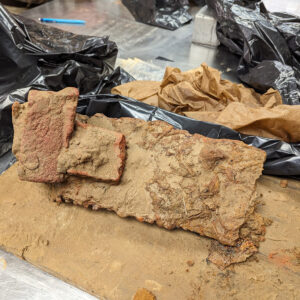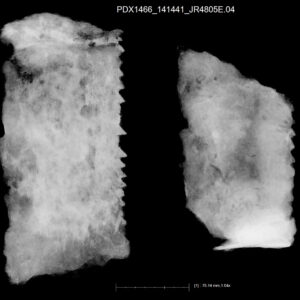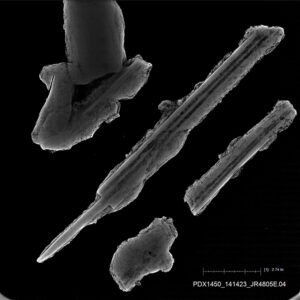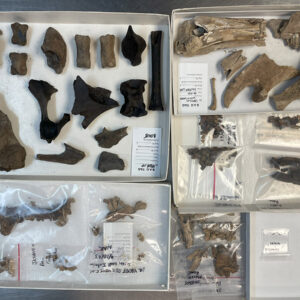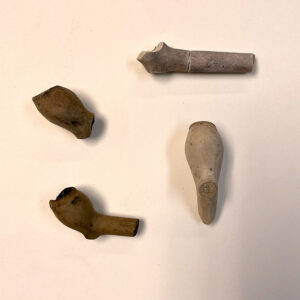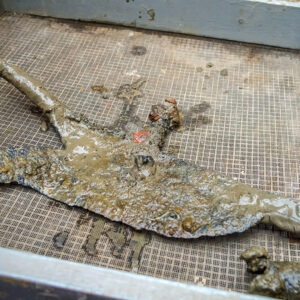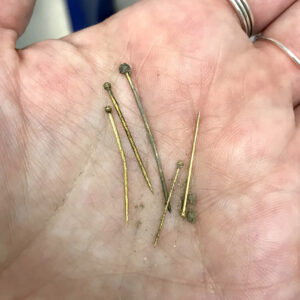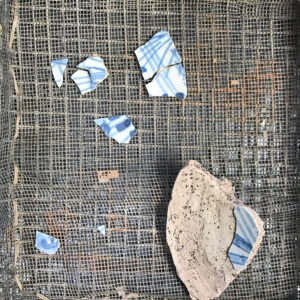The bottom of the ca. 1617 Governor’s Well has been reached, and while fighting a constant battle against water, the Jamestown Rediscovery archaeologists have excavated a wealth of artifacts ranging from swords to shoes. Because the team was at the level of the water table (and below) they used several pumps and built a French drain to keep the water away from the working surface. Shortly after exposing the bottom of the well, water came back again, often forcing the archaeologists to rely on touch rather than sight as they scoured the bottom for objects. Pumps would work until they wouldn’t — sometimes clogging and forcing the team to stop and get them working again. They broke spare modern bricks to construct a French drain, working with gravity to dry the builder’s trench around the well where they worked. And they used harnesses and rope to secure themselves as they reached down into the well to find artifacts. At the end of one afternoon when they thought they’d be able to touch the bottom, they found it was just beyond their reach, forcing them to come back the next day and take down several more courses of brick. They could then feel around the bottom more completely and excavate artifacts that saw daylight for the first time in 400 years. The team took turns reaching down into the well to limit their time being upside down. A second team of archaeologists and conservators was topside, waiting with water-filled plastic bins and screen trays. The bins were available to rapidly re-immerse any waterlogged artifacts to prevent them from drying out. Trays were also at the ready to hold other artifacts on their way to the lab for analysis and conservation. A third team stood a few feet away screening bucketfuls of soil excavated from the well, searching for smaller artifacts. Large concretions of artifacts, soil, and corrosion were also triaged here, with archaeologists applying gentle showers of water from garden hoses to wash away the dirt and reveal what was hidden inside. And both physical and virtual visitors were able to watch in real time, whether on the viewing platform constructed by the archaeologists or on the Governor’s Well webpage.
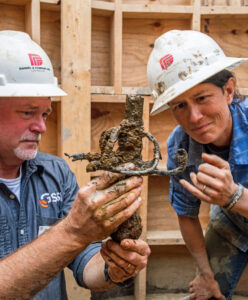
The lab is a beehive of activity, with curators and conservators processing hundreds of new artifacts from a waterlogged environment that requires special consideration. For artifacts that have been submerged for 400 years — whether they be iron, wood, leather, or bone — to be exposed to the air can cause corrosion, loss of structural integrity due to moisture loss, or consumption by aerobic bacteria. The collections and conservation staff take a professional approach, seeking to first quickly stabilize artifacts to prevent degradation. For those artifacts that have been underwater for centuries, this often means resubmerging them. Iron artifacts are placed in the dry room where humidity and temperature are adjusted to create an ideal environment for corrosion inhibition. During the last few days of September, curators and conservators went back and forth between the well and the lab on golf carts and UTVs, ferrying artifacts indoors to quickly begin the conservation process. And the team has their work cut out for them as the well didn’t disappoint. As with most of the other wells in and around James Fort, the colonists used this one as a trash pit once its water was no longer potable. Other artifacts likely fell in while the well was still being used as a water source.
Just above the water line, the first sword was found. Just the blade, it was hidden by corrosion and soil and concreted to the side of the well. After it was excavated, several other smaller blade pieces were found which may be part of the same sword. The longest, initial piece was X-rayed, revealing letters — perhaps a maker’s mark — near the center of the blade. As the blade is fully encased in a corrosion crust we are hopeful that the conservation process (including removal of the corrosion) will allow a clearer view of the letters than what the X-ray will allow. Another partial sword — though relatively complete in comparison to most swords found at Jamestown — is made up of a partial blade, a hilt, a handle, and a pommel, all still attached to each other. The hilt is of the “swept” style and other pieces found later in the excavations appear to be part of the same hilt. The sword appears to have a close, Spanish-made parallel in the Victoria and Albert Museum in London dating to the fourth quarter of the 16th century. A thicker hilt with a partial handle possibly belonging to a broadsword was also found in the well. Excavated as an amorphous object encased in dirt, it was revealed by Staff Archaeologist Caitlin Delmas at the water screening area by gently washing away the soil surrounding it. This one is missing its pommel and blade. Other iron weapons found in the well include a dagger blade (or the end of a sword blade) and a bill. Bills were polearm weapons, their blades mounted on long wooden poles, and they were effective against both infantry and cavalry. The bill is in remarkably good shape, its watery home protecting it from the corrosion it would have faced above the surface. At least 15 have been found at Jamestown, many likely part of a gift of arms and armor given to the colonists by King James I after the 1622 Powhatan uprising. A gun barrel was also found in the well, with the muzzle end appearing to have exploded and the stock end being faceted. The barrel’s surface is missing in many places and a concretion of soil and corrosion is present throughout. Armor has also been found, all of it fairly fragmentary. Two pieces bear buckles and are likely parts of tassets, armor that protected the upper thighs. We are hoping that further conservation will reveal clues to help identify the other armor pieces but they may prove too fragmentary. One of the other highlights of the iron artifacts is a saw blade, at least four pieces of which were found in the well. It appears to be the largest saw blade in the Jamestown Rediscovery collection, and its teeth are readily visible even before conservation. There are about 20 saw blade fragments in the collection as a whole.
On the organic side, several leather shoe fragments were found, including an adult shoe midsole/outsole and two surviving nails binding the pieces together. Faunal bones found in the well include that of deer, cattle, and pig. But there are substantially fewer bones in this well (a few dozen) than in the fort’s first or second wells, which both contained many thousands. This smaller number of bones mirrors the Smithfield Well, thought to have been built around the same time. Perhaps the colonists had designated spaces for food waste (or trash in general) at this point that they didn’t when the first two wells were filled in. Another interesting organic artifact excavated from the well is a wooden comb, found in three pieces. There are different sized teeth on each side, with one side used for a typical grooming regimen, and the small teeth useful in picking out nits like lice! Other organic artifacts excavated from the well include at least 7 plum stones (seeds), rope fragments, insects, and leaves.
There were relatively few ceramics found in the well. Multiple pieces of a shattered dish are likely Delftware, coming either from the Netherlands or England, the curators leaning towards this identification due to its slightly pinkish paste, the shape of its footring, and the fact that its footring is pierced. Fragments of a Midlands purple vessel were also found. At Jamestown these are almost always butter pots and tend to be excavated from early fort-period contexts. Sherds of a Spanish coarseware olive jar are another type of ceramic found in the well. Despite its name, they were used to carry all sorts of commodities, not just olives or olive oil.
Among the glass vessels to come out are the broken pieces of at least three case bottles. This type of case bottle was used in the first half of the 17th century and so these are a good indicator of the well’s early date. Two ornate, twisting blue and clear glass segments — possibly part of a goblet — were found that are of the Façon de Venise (“in the fashion of Venice”) style. European glassmakers outside of Venice were copying the styles of that city’s craftsmen, making origin identification difficult. Another glass artifact of note from the well is a gooseberry bead. There are about 300 of these in the Jamestown collection, so although not rare their striking appearance makes them a favorite of the curatorial team.
A few pipe fragments were found in the well, one with a complete bowl, heel, and stem. Another has a stamped heel. The symbols in the stamp could be the letters “TG” with decorative flourishes above and below the letters. Other “TG” pipes have been found at Jamestown though unfortunately in mixed contexts. If this pipe does in-fact bear an “TG” stamp then it will be the first one found in a well-defined context. This could help the curatorial team date and identify the “TG” pipes. Pipes with similar “TG” maker’s marks have been found at other sites in Virginia, Canada, and England.
Some interesting copper alloy artifacts were also found, including several straight pins and a complete spoon with a symbol stamped into it — probably a maker’s mark. The stamp is comprised of a heart and two capital “I”s. “I”s in this period were used to represent the letter “J” so it is possible that the spoon’s maker had a first name and last name starting with “J.” The spoon has a fig-shaped bowl and a handle with a slip-top stem that aligns with other early 17th-century spoons.
Finally, a single silver spangle was found in the well. These decorative pieces, similar to a sequin, were also found in the burial of Captain William West, where they adorned his captain’s sash.
The team was excited to welcome Dr. Jason Anderson and his students from Archbishop Hoban High School in Akron, Ohio to the Island for two days of hands-on archaeological instruction. The first day was spent in the field conducting excavations at the clay borrow pit under the guidance of archaeologists Sean Romo, Caitlin Delmas, Hannah Barch, and Josh Barber. The students uncovered an ash/charcoal feature there and found a crucible base and a Nueva Cadiz bead. In addition to instruction in traditional archaeological techniques such as shoveling, troweling, and screening, Senior Staff Archaeologist Sean Romo also instructed them in ground-penetrating radar (GPR) surveying, an increasingly-indispensable skill in the field. The next day the students worked with the conservation and curatorial teams. The students were given a tour of the lab and the Vault and the curatorial team discussed how artifacts move from the field to the lab. The students then participated in a picking activity of artifacts from the fort’s first well, learning to identify tiny objects such as animal bones and beads.
well cam video highlights
- September 19: Saw blade
- September 19: Dagger (or the end of a sword) blade
- September 21: Sword
- September 27: Bill
- September 28: Shoe sole
- September 28: Adze
- September 28: Burned wall fragment
- September 28: Possible tasset pieces
- September 28: Rope fragments
- September 28: Spoon
well excavation timelapse
related images
- Senior Staff Archaeologists Sean Romo and Mary Anna Hartley discuss the Governor’s Well excavations.
- Site Supervisor Anna Shackelford conducts excavations of the Governor’s Well.
- Site Supervisor Anna Shackelford holds a fragment of a case bottle found in the Governor’s Well.
- Site Supervisor Anna Shackelford hands a case bottle fragment to one of the archaeologists at the surface.
- Archaeologists Josh Barber and Hannah Barch at the Governor’s Well
- Staff Archaeologist Caitlin Delmas uses water to reveal a sword hilt hidden inside an earthen blob.
- Staff Archaeologist Caitlin Delmas shares the sword hilt she found while water screening with visitors. President of the Jamestown Rediscovery Foundation Dr. Jim Horn describes the artifact to the visitors.
- The dagger (or the end of a sword) blade found in the Governor’s Well
- The archaeological staff built a French drain to help keep water away from the working surface.
- Governor’s Well excavations, September 28, 2023
- Senior Archaeological Conservator Dan Gamble and Senior Staff Archaeologist Mary Anna Hartley shortly after the discovery of the bill
- Director of Archaeology David Givens holds one of the copper alloy pins found in the Governor’s Well.
- Site Supervisor Anna Shackelford and Director of Archaeology David Givens examine the burned wall fragment found in the Governor’s Well.
- The burned wall fragment found in the Governor’s Well
- Director of Archaeology David Givens holds the saw blade fragments found in the Governor’s Well.
- Archaeological Field Technician Ren Willis holds the wooden comb shortly after it was excavated.
- Archaeological Field Technician Ren Willis holds the wooden comb found in the Governor’s Well.
- The wooden comb found in the Governor’s Well
- Wood fragments found in the Governor’s Well
- Senior Staff Archaeologist Mary Anna Hartley examines rope fragments found in the Governor’s Well.
- A closeup of the rope fragments found in the well
- Director of Archaeology David Givens examines the copper alloy spoon found in the Governor’s Well.
- Leather shoe fragments found in the Governor’s Well. Two nails can be seen in the toe area of the largest sole piece. The nails are holding the inner sole to the outer sole.
- Director of Living Trades Willie Balderson (dressed as colonist Anas Todkill) discusses some of the finds with Archaeological Conservator Dr. Chris Wilkins.
- The pipe with the possible “TG” stamp on its heel
- An iron adze found in the Governor’s Well
- Curator Leah Stricker with some of the soil samples from the Governor’s Well. The soil has been saved so that finds like small seeds can be recovered by archaeobotanists with the help of a microscope.
- A burned cow hoof found in the Governor’s Well
- Fragment of a Façon de Venise glass vessel found in the Governor’s Well
- A gooseberry bead found in the Governor’s Well
- Spanish coarseware olive jar fragments found in the Governor’s Well
- Two armor fragments, perhaps part of tassets, still bearing buckles. These were found in the Governor’s Well.
- One of the armor pieces (likely a tasset) complete with a buckle to attach it to other pieces of armor
- The thicker hilt uncovered while water screening
- Archaeological Conservator Dr. Chris Wilkins removes soil concretions from one of the sword hilts found in the Governor’s Well.
- The swept sword hilt found by Staff Archaeologist Caitlin Delmas while water screening. It’s being kept in a humidity-controlled container during conservation.
- Curator Leah Stricker holds a tray of sword blade fragments found in the Governor’s Well. The one furthest from the camera is the sword that bears the letters revealed by X-ray. Future conservation may reveal that some of these belong to the same weapon.
- The gun barrel found in the Governor’s Well.
- Curator Leah Stricker holds a tray of sword and/or dagger blade fragments found in the Governor’s Well. The one furthest from the camera is the sword that bears the letters revealed by X-ray. Future conservation may reveal that some of these belong to the same weapon.
- A sword excavated from the Governor’s Well. This is one of only two examples in the Jamestown collection to have a pommel, handle, hilt, and partial blade.
- Smaller pieces of a hilt also found in the Governor’s Well appear to mend to one of the swords.
- Additional hilt fragments that likely are part of one of the swords found in the Governor’s Well.
- Braided copper alloy wire found on the handle of one of the swords
- Archaeological Conservator Dr. Chris Wilkins processes an X-ray of one of the swords found in the Governor’s Well.
- An X-ray of the sword hilt/blade/pommel/handle found in the Governor’s Well. The image has a multi-scale enhancement filter applied that evens out the contrast between dense and thinner parts of the object.
- An X-ray of one of the swords found in the Governor’s Well
- Members of the collections and conservation teams process artifacts found in the Governor’s Well.
- Bone fragments found in the Governor’s Well
- The saw blade found in the Governor’s Well. It is concreted to brick fragments. Note the visible saw teeth along the bottom edge.
- An X-ray of two saw blade fragments found inside the Governor’s Well
- An X-ray of one of the sword blades found in the Governor’s Well. Lettering can be seen on the longest piece.
- An X-ray of one of the blades found in the Governor’s Well reveals letters, probably a maker’s mark. Hopefully the letters will become clearer once the blade is conserved.
- Some of the arms and armor found in the Governor’s Well. Modern reproduction tassets and sword at center.
- The spoon’s maker’s mark as seen through a microscope
- Bones found in the Governor’s Well
- Curator Leah Stricker holds some of the plum stones found in the Governor’s Well.
- The pipe fragments found in the Governor’s Well.
- The bill found in the Governor’s Well
- The bill found in the Governor’s Well
- Copper alloy pins found in the Governor’s Well.
- Sherds of a dish found in the Governor’s Well, likely Delftware from either the Netherlands or England.



